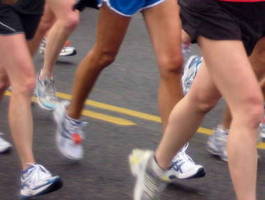
With spring right around the corner-and so many events-I thought it was time for me to remind you about some running basics that might keep you from getting injured along the way; the most common injury being knee pain.
My clients have reminded me that three of the many things required for running without knee pain, particularly in distance training, are a good base, the right shoes and the proper cadence.
The knee pain I am concerned with is at the lower outside front of the knee. (Read more about this type of injury, commonly called "Runner's Knee" inRunOregon's five-part series about what Runner's Knee is and what to do if you have it.) It hurts during the run and gets worse as you run, and stops once you stop. I have had this type of irritation. My first prognosis is the shoe. Blame the shoe because it is a good
sign that your shoes are starting to need replacement, and for many runners this is true.
My clients have reminded me that three of the many things required for running without knee pain, particularly in distance training, are a good base, the right shoes and the proper cadence.
The knee pain I am concerned with is at the lower outside front of the knee. (Read more about this type of injury, commonly called "Runner's Knee" inRunOregon's five-part series about what Runner's Knee is and what to do if you have it.) It hurts during the run and gets worse as you run, and stops once you stop. I have had this type of irritation. My first prognosis is the shoe. Blame the shoe because it is a good
sign that your shoes are starting to need replacement, and for many runners this is true.
If you listen and act on ONLY ONE THING in this article, do this. Go to a professional running store and make sure that they fit you in the right shoe for you and your gait. Sure you may be able to get them from some other venue, but at least for your running, get fit by someone who is a runner. Going to a warehouse or a Factory Outlet is just going to cause you to waste your money and likely end up with an injury. Unless you know what you need, you are too likely to buy the wrong shoe.
With each new pair of shoes I buy, I mark them with the date. About 300 miles later, they become street shoes because for running they are shot. That is about three months for me.
But sometimes it is not about the shoe; it’s about the length of your stride, and your route.
For example, this pain can result from doing a lot of hills. Running downhill puts a significant amount of force on the knee joint. We sometimes have a tendency to over-stride (lengthen our step) the downhill. Cornell, Miller, Barnes Road and Cedar
Hills Boulevard out in my neighborhood make a nice hilly loop that is a good example.
Once I get up to either side of Miller Road, I am ready to rip down the hill as fast as my legs will carry me and get back to a level road. Either side is about one mile of fairly good decent, but Barnes Road particularly drops rather aggressively all the way down. This is a good recipe for knee pain. As I have since learned the hard painful way. It is hard to go fast down hill without hyper extending your knee or obtaining a turnover (cadence) that is faster than you should be running. And having to stop to avoid a red light or a driveway really puts the energy into the joints.
Another cause of this type of knee pain is not having a good enough base. So what is a good base anyway? The longest run of the week should be no more that 25-30% of your total mileage for any given week. So lets say last week you ran 20 miles last week. Your longest run should be 5-6 miles with the other 14-15 miles spread over three or four days, with two days your lowest mileage or easy days at 2 or 3 miles, and one or two days that were a little longer, say 3 or 4 miles. This leaves your longest run for Saturday, or Sunday, of 5 or 6 miles. You should keep your weekly mileage increases to less that 10% total. All of these miles should be at 70-80% of your race pace.
If your training for a 5K or 10K, this should be a good base for you.
For a half marathoner, 25-30 miles consistently over four to six weeks is about right.
For a marathoner, I like to see your base approaching 40 miles per week or more, for 4-6 weeks, before you even start thinking about speed-work of any kind.
This BASE is essential if you are considering any type of speed work towards a Personal Record.
The proper cadence is also really helpful in getting comfortable as a distance runner, and avoiding knee pain and other injuries.
How fast is your cadence? Check it out. Count the number of times your left foot strikes while running on a flat surface in 30 seconds. If it is about 45, that means your cadence is about 90 bpm (beats per minute), and you should be good to go. And check it often, give yourself a POP quiz, and make sure it’s about 90 bpm give or take a few strikes.
So there you are, hitting the pavement with your knees nearly in a locked position. Not healthy in the long run. Over time, and sometimes very quickly, you can create tendonitis in the connective tissues in the knee, hip and ankle joints.
So a simple remedy for this is to make sure your strides remain shorter with your knee always hits the ground with a bend in it. Let gravity pull you but stay under control of your foot strikes.
Another cause is often the tendency to concentrate on a long slow stride rather than a good cadence.
Runners frequently run down hills increasing their cadence and/or lengthening their stride because it is EASY to do. Unfortunately, your connective tissue is not likely to be ready for the additional speed and impact forces. Leave that to a few Wildwood Trail runs.
Many of the best runners have a cadence that is somewhere close to 90 beats per minute. It seems that once your cadence is about 90 beats per minute, or 180-foot strikes per minute, you reach an optimum stride length that you can easily maintain. As reported in Triathlete magazine in an article about cadence by Lance Watson and Lucy Smith, there have been several studies on athletes ranging from elite to recreational. The findings include that on flat surfaces, most run at 90 beats per minute. And it appears that this cadence is the same whether they are warming up or racing. What changes is small variations their stride length.
I am bringing this up now, because so many folks are starting their training for some event in the spring or summer. And they may find that the pace they are working with is maybe too slow. So they speed up. There are two ways to speed up, increase stride length and/or cadence.
To avoid injury, I recommend that you mimic the best runners and focus on your cadence first and once you maintain 90 bpm (Basebuilding), then play with your stride length by making small incremental changes (Sharpening/Speedwork).
When you try to increase cadence and stride length at the same time, you are likely on the way to pain in the front or lower knee and a lot of frustration.
I know we had several runners that were wondering if they were in the right pace group. Pace groups are set up based on your predicted finish time, and your current fitness level. Since these long runs, and your mid week runs, are done at less than
80% effort, it may feel too slow.
Indeed, it is designed to be just that way. But if you feel like you should be going faster, AND you have the right cadence, AND your heart rate is about 80% of your max, then maybe you should move to another pace group.
But I would caution you to get into a pace group that is more than 10% faster than your predicted finish.
So, now is a good time that you focus on your base and your cadence. Make sure you are comfortable with maintaining about 90 beats per minute.
You will find that your training and your racing will feel much better, if you are running at a cadence of about 90 beats per minute, as long as your shoes are in good shape.
Jim Mattern is an RRCA Certified Running Coach in Portland. "Coach Jim" offers a free long training run every Saturday (year-round) from various locations in the Portland area. All are invited and welcomed at his training runs.
http://networkedblogs.com/ezABe
With each new pair of shoes I buy, I mark them with the date. About 300 miles later, they become street shoes because for running they are shot. That is about three months for me.
But sometimes it is not about the shoe; it’s about the length of your stride, and your route.
For example, this pain can result from doing a lot of hills. Running downhill puts a significant amount of force on the knee joint. We sometimes have a tendency to over-stride (lengthen our step) the downhill. Cornell, Miller, Barnes Road and Cedar
Hills Boulevard out in my neighborhood make a nice hilly loop that is a good example.
Once I get up to either side of Miller Road, I am ready to rip down the hill as fast as my legs will carry me and get back to a level road. Either side is about one mile of fairly good decent, but Barnes Road particularly drops rather aggressively all the way down. This is a good recipe for knee pain. As I have since learned the hard painful way. It is hard to go fast down hill without hyper extending your knee or obtaining a turnover (cadence) that is faster than you should be running. And having to stop to avoid a red light or a driveway really puts the energy into the joints.
Another cause of this type of knee pain is not having a good enough base. So what is a good base anyway? The longest run of the week should be no more that 25-30% of your total mileage for any given week. So lets say last week you ran 20 miles last week. Your longest run should be 5-6 miles with the other 14-15 miles spread over three or four days, with two days your lowest mileage or easy days at 2 or 3 miles, and one or two days that were a little longer, say 3 or 4 miles. This leaves your longest run for Saturday, or Sunday, of 5 or 6 miles. You should keep your weekly mileage increases to less that 10% total. All of these miles should be at 70-80% of your race pace.
If your training for a 5K or 10K, this should be a good base for you.
For a half marathoner, 25-30 miles consistently over four to six weeks is about right.
For a marathoner, I like to see your base approaching 40 miles per week or more, for 4-6 weeks, before you even start thinking about speed-work of any kind.
This BASE is essential if you are considering any type of speed work towards a Personal Record.
The proper cadence is also really helpful in getting comfortable as a distance runner, and avoiding knee pain and other injuries.
How fast is your cadence? Check it out. Count the number of times your left foot strikes while running on a flat surface in 30 seconds. If it is about 45, that means your cadence is about 90 bpm (beats per minute), and you should be good to go. And check it often, give yourself a POP quiz, and make sure it’s about 90 bpm give or take a few strikes.
So there you are, hitting the pavement with your knees nearly in a locked position. Not healthy in the long run. Over time, and sometimes very quickly, you can create tendonitis in the connective tissues in the knee, hip and ankle joints.
So a simple remedy for this is to make sure your strides remain shorter with your knee always hits the ground with a bend in it. Let gravity pull you but stay under control of your foot strikes.
Another cause is often the tendency to concentrate on a long slow stride rather than a good cadence.
Runners frequently run down hills increasing their cadence and/or lengthening their stride because it is EASY to do. Unfortunately, your connective tissue is not likely to be ready for the additional speed and impact forces. Leave that to a few Wildwood Trail runs.
Many of the best runners have a cadence that is somewhere close to 90 beats per minute. It seems that once your cadence is about 90 beats per minute, or 180-foot strikes per minute, you reach an optimum stride length that you can easily maintain. As reported in Triathlete magazine in an article about cadence by Lance Watson and Lucy Smith, there have been several studies on athletes ranging from elite to recreational. The findings include that on flat surfaces, most run at 90 beats per minute. And it appears that this cadence is the same whether they are warming up or racing. What changes is small variations their stride length.
I am bringing this up now, because so many folks are starting their training for some event in the spring or summer. And they may find that the pace they are working with is maybe too slow. So they speed up. There are two ways to speed up, increase stride length and/or cadence.
To avoid injury, I recommend that you mimic the best runners and focus on your cadence first and once you maintain 90 bpm (Basebuilding), then play with your stride length by making small incremental changes (Sharpening/Speedwork).
When you try to increase cadence and stride length at the same time, you are likely on the way to pain in the front or lower knee and a lot of frustration.
I know we had several runners that were wondering if they were in the right pace group. Pace groups are set up based on your predicted finish time, and your current fitness level. Since these long runs, and your mid week runs, are done at less than
80% effort, it may feel too slow.
Indeed, it is designed to be just that way. But if you feel like you should be going faster, AND you have the right cadence, AND your heart rate is about 80% of your max, then maybe you should move to another pace group.
But I would caution you to get into a pace group that is more than 10% faster than your predicted finish.
So, now is a good time that you focus on your base and your cadence. Make sure you are comfortable with maintaining about 90 beats per minute.
You will find that your training and your racing will feel much better, if you are running at a cadence of about 90 beats per minute, as long as your shoes are in good shape.
Jim Mattern is an RRCA Certified Running Coach in Portland. "Coach Jim" offers a free long training run every Saturday (year-round) from various locations in the Portland area. All are invited and welcomed at his training runs.
http://networkedblogs.com/ezABe
 RSS Feed
RSS Feed







